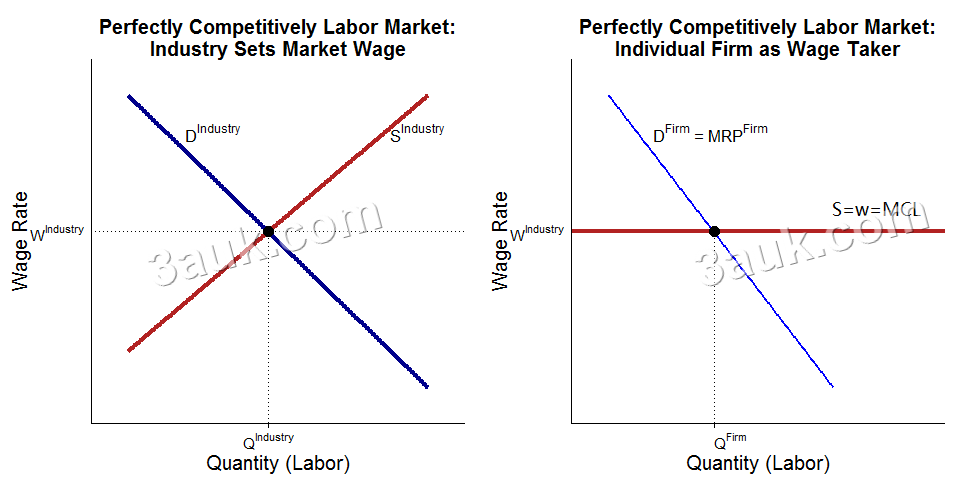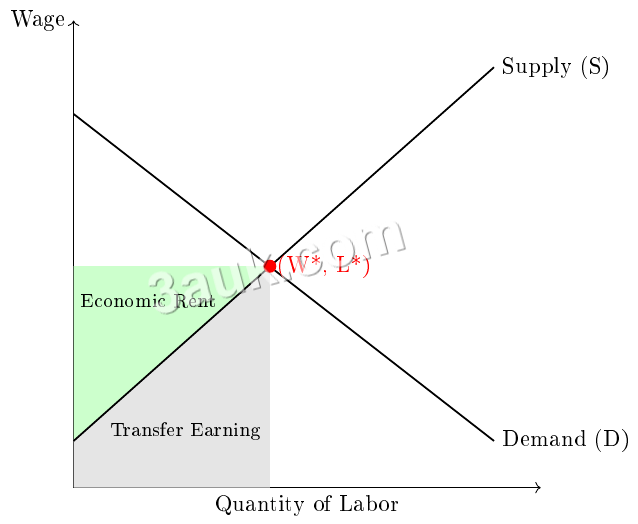Content
- Topic Questions (MCQ – EASY): Labour market forces, MRP theory
- Topic Questions (MCQ – HARD): Labour market forces, MRP theory
wage determination in perfect markets: equilibrium wage rate and employment in a labour market

- The equilibrium wage rate and employment level occur at the point where the labor demand curve intersects the labor supply curve.
- At this equilibrium, the quantity of labor demanded equals the quantity of labor supplied, and there is no excess demand or supply in the labor market.
- shifts in industry supply and demand affect the wage rate
- For an individual firm, given wage w, it maximizes profits by hiring up to where MCL=MRPL, i.e. the incremental cost by hiring one more labor equals the extra value created
- thus the firm's demand for labor curve is its MRPL curve
- The industry's demand for labor curve is the sum of all firms’ demand curve
determination of wage differentials by labour market forces
Reasons for wage differentials in perfectly competitive labour markets
- Differences in productivity and marginal value of products produced by labour
- Differences in supply and PES
- Low pay jobs (e.g. cleaners) often associated with
- low productivity and/or low value of products;
- large amount of and highly elastic supply of qualified labour
- the reverse is true for high pay jobs
transfer earnings and economic rent

Transfer earnings and economic rent are concepts used to analyze the distribution of income in an occupation or industry.
- Transfer earnings refer to the minimum income necessary to keep a factor of production (such as labor) in its current use.
- It represents the opportunity cost of using the factor in its next best alternative use.
- In the context of labor, transfer earnings represent the wage rate that a worker could earn in their next best alternative occupation or industry.
- Economic rent refers to the income earned by a factor of production (such as labor) that exceeds its transfer earnings.
- It represents the surplus income or "extra" income earned due to the uniqueness, scarcity, or special skills possessed by the factor.
- Economic rent is the difference between the actual earnings received by the factor and its transfer earnings.
Factors Affecting Transfer Earnings and Economic Rent in an Occupation:
- Scarcity and Demand: The scarcity of certain skills or qualifications in an occupation can increase transfer earnings and economic rent.
- If there is high demand and limited supply for specific skills, workers possessing those skills can command higher wages and earn economic rent.
- Uniqueness and specialization in certain occupations or industries can lead to higher transfer earnings and economic rent.
- For example, individuals with rare talents or expertise that are in high demand may be able to earn higher wages and enjoy economic rent.
- Market power held by workers or labor unions can influence transfer earnings and economic rent.
- If workers have strong bargaining power or are part of a union, they may be able to negotiate higher wages and secure economic rent.
- Education and Training: The level of education, training, and qualifications required in an occupation can impact transfer earnings and economic rent.
- Occupations that demand extensive education and specialized training may have higher transfer earnings and the potential for economic rent.
- Labor Market Conditions: The overall supply and demand conditions in the labor market can affect transfer earnings and economic rent.
- In industries with high demand and limited supply of skilled labor, transfer earnings and economic rent may be higher.
Join the conversation